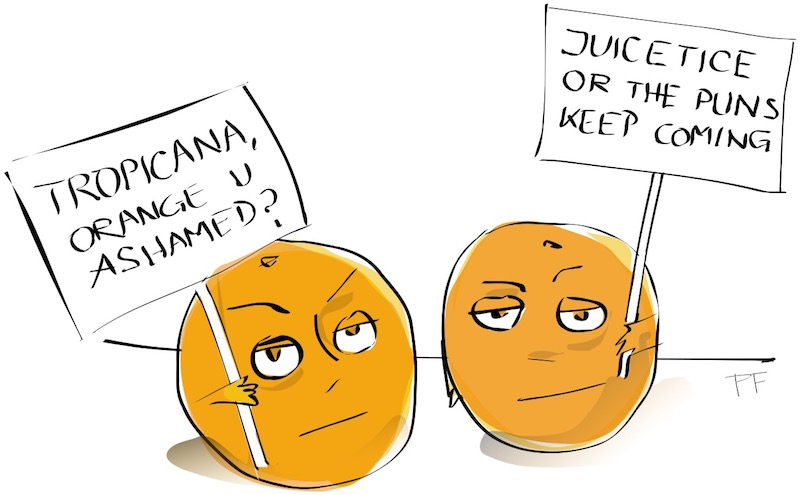Why I became disloyal to Tropicana – A story about brand image
I have been fiercely loyal to Tropicana since late 2005. At that time, I attended the Creating Breakthrough Strategy course at Columbia. One of the lecturers was Willie Pietersen, a person I admire greatly. He is the author of Strategic Learning and runs an influential think tank. I found his course intensely practical, probably because he had been the CEO of several companies, including Tropicana. He explained their business strategy in some detail, focusing on their decision process for coming up with the strategy in the first place. They decided that their key differentiator in the market would be that they would never make juice from concentrate. I found that argument persuasive, and stopped buying any other juice. Until last month.
What happened?
So what happened and what should we learn from it? I receive two Swiss consumer magazines every month. In their May 2017 issue, Mieux Choisir had a major focus on orange juice. I learned quite a few things that I did not like. Apparently, half the oranges used for juice in the world are from Brazil. The European Union has highlighted the imposition of low purchase prices on poor farmers, who can barely survive. The magazine encourages consumers to buy juice from companies that are members of one of the various associations that guarantee a decent living to the growers, whether in Brazil or in other countries, including the USA. Tropicana is apparently a problem here, as were half the other juice brands in the test. They received the lowest of the three grades awarded for ‘social and environmental aspects’. Since I found this hard to believe, I checked out the Tropicana website, and found nothing on the subject. It is clear that they source at least some of their oranges in Florida, though nothing is said about the conditions. Here in Switzerland, they have recently changed their packaging to emphasize that their oranges come from Brazil. (I would have expected to find it in the ‘Grove to Glass’ subset of the ‘Our Story’ section on tropicana.com. If you can find something relevant elsewhere, just let me know and I will correct this article and inform the magazine editor.) Result: I stopped buying Tropicana.
Brand image factors can matter just as much as purchase and support experience
Customer experience is a complex thing. The simplicity and effectiveness of purchase, implementation and support process matter for many products, as do the attributes of the products themselves. So does brand image. When I worked at HP, brand image factors accounted for about one-third of customer happiness for hardware products, and about half for software. Working on brand image attributes matters, if you want loyal customers. They are hard to improve, and often involve the full leadership team.
Some companies don’t care about brand image
Typically, these are companies in dominant positions in their markets. Consider one example, from 2016. Mylan, the only supplier of EpiPens, put up their prices by a factor of six. There was a global outcry, as the pens are used by people with severe allergy problems. They can go into ‘anaphylactic shock’, and jabbing them with an EpiPen fixes it. The CEO, Heather Bresch, even did her best to defend the price increases in front of the US Congress. Fortune ran an article saying the price increases “crossed ethical boundaries.” They even had to pay $465 million to settle “U.S. Justice Department allegations that it overcharged the government for EpiPen.” Various pension funds are currently trying to prevent the re-election of six board members. The CEO’s compensation went up by 700%. While they did some PR about the new price, they do not appear to have put it down following all the uproar. As far as I can tell, it now costs $640 in the USA, up from a much earlier price of $50. Bottom line: “We are just running a business.”
Suppliers are important stakeholders for all companies too
I was listening to a business podcast last week. Unfortunately I can’t remember what one it was. Probably NPR Planet Money, or maybe Freakonomics or the HBR podcast. The speaker said you can’t run a successful business when you only try to keep “one of the three stakeholder groups happy.” He defined the stakeholder groups as shareholders, customers, and employees. I feel suppliers are an equally important stakeholder group. A balance is needed. I feel this has changed over the last ten years. The average person cares more than they used to.
Dairy farmers as an example
At the moment, in Switzerland and many other countries, dairy farmers are having a hard time being profitable. Milk distributors have been paying less and less for milk over the last 10 to 15 years. Farmers are going out of business, and their suicide rate seems higher than in the general population. Across Europe and in many other countries, they receive government subsidies. In practice, our tax money is not winding up in the farmers’ hands, but in those of the distributors and supermarket chains. (Yes, I have been taught the Porter ‘five forces model’ and understand that one of the five factors that affects profitability of a business is the ability of customers to set prices. There is still a difference between what is legal and what is ethical.)
Back to Tropicana
As soon as Tropicana adheres to the practices promoted by ‘Fairtrade’ or a similar association, I will start to buy their products again. This is consistent with my approach for my favorite fruit: bananas. I only buy ‘Max Havelaar Fairtrade’ bananas, even though they are a little more expensive. The brand image matters to me.
As always, feel free to comment and disagree below.



